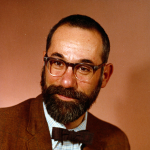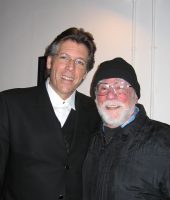Stan Ruttenberg
March 12, 1926 – February 12, 2017
 Longtime Boulder resident Stan Ruttenberg died Sunday, February 12, 2017 at Balfour Senior Living in Louisville. He was 90..
Longtime Boulder resident Stan Ruttenberg died Sunday, February 12, 2017 at Balfour Senior Living in Louisville. He was 90..
Stan was born on Mar 12, 1926 in St. Paul, Minnesota, to Edward Ruttenberg and Goldene (Moss) Ruttenberg, where the extended family was living after prior generations emigrated from Romania, Ukraine and Russia.
Ed and Goldie moved to Philadelphia in 1929, where second son Herbert was born in 1930. Ed worked with the Moss Brothers Peanut Company and Goldie operated the Dixie Anna Cafe with her sister Beck. The Moss Brothers expanded to Pittsburgh as Chunk-E-Nut, and in 1940, Ed moved his family there and ran the plant.
During the war years, Stan attended college year-round, starting at Johns Hopkins in the summer quarter when he was 17, and then transferring to MIT to graduate in June, 1946 with a Bachelor of Science in Physics. While at Johns Hopkins, he joined Alpha Epsilon Pi, and while at MIT was elected to Sigma Xi. He contributed to the Manhattan project with his experiments on MIT’s Cyclotron.
At age 20, Stan followed members of his extended family to Los Angeles by driving cross-country with his brother Herb, arriving in the summer of 1946. He pursued graduate studies at UCLA, earning a Master of Arts in Physics in 1951 and starting course work towards a PhD.
During this time, Stan planted the seeds for his life-long enjoyment of the outdoors with many trips to the High Sierra, and with friend Dick Kelty came up with the idea for the light-weight external-frame backpack.
Stan became known for his penchant for electronics, which he combined with a love of classical music to tinker with reel-to-reel tape decks. One of these was used to record the signal of artificial aurora from rocket launches at White Sands Missile Range for a fellow student’s PhD project. Another time, he was invited to the home of Arnold Schoenberg because he had the only equipment to play studio recordings of the Schoenberg string quartets that were recorded on 16″ acetate disks.
From Sept 1952 through Feb 1953, he sailed on the ship Horizon to conduct atmospheric-electric research during Operation Capricorn. Horizon sailed on a counter-clockwise track around Hawaii, Kwajelein, Fiji, Tonga and Tahiti, and was close enough to the Marshall Islands for Stan to witness an H-bomb test during Operation Ivy.
In 1950, Stan met fellow student Patricia Childress when she started working for the UCLA Institute of Geophysics as a numerical analyst. They discovered their common interests in music and logic, plus discovered that Pat had gone to high school with Stan’s brother Herb, babysat for Stan’s uncle Dr. Arthur Moss and taken a physics course with Stan’s cousin Dr. David Saxon. The stars thus aligned, they were married on Feb 16, 1955 in Los Angeles.
In July of that year, Pat and Stan moved to Washington, DC where Stan took a position at the National Academy of Sciences (NAS), and Pat worked at the Bureau of Standards (now NIST). Their two daughters, Alison and Rebecca, were born during these years.
At the NAS, Stan was technical adviser for the award winning series “Planet Earth” in 1960-62 (updated in 1980-85). He was head of the program office for the U.S National Committee for the International Geophysical Year (IGY) and was executive secretary to its follow-on program, the International Year of the Quiet Sun (IQSY). Through the IGY, he became acquainted with Dr. Walter Orr Roberts, who invited Stan to work at the National Center for Atmospheric Research (NCAR) in Boulder, CO. In 1964, the family made the move and Stan built a house that Pat designed on the edge of NCAR property at the top of Kohler Drive.
Stan was to spend the rest of his scientific career associated with NCAR. He worked as assistant to Dr. Walt Roberts and subsequent NCAR directors and UCAR presidents. He organized many international workshops and traveled extensively, which led to a stint at the World Meteorological Organization (WMO) headquarters in Geneva, Switzerland, where the family lived for the summer of 1970 and the school year starting summer of 1971.
Stan was the assistant to the Joint Planning Staff for the Global Atmospheric Research Program (GARP), and oversaw the student program in the GARP Atlantic Tropical Experiment (GATE). He oversaw the early programs in the Cooperative University Programs (CUPS) and become acting director of the UCAR Projects Office (now UCAR Community Programs). One UCAR project that Stan directed was CSNET, a forerunner of the National Science Foundation Network (NSFNet) which eventually became a backbone of the Internet.
Stan was appointed Secretary General of the International Association of Meteorology and Atmospheric Physics (IAMAP, now IAMAS), a position that he held from 1975-1987. Starting in 1983, Stan was Scientific Advisor to the NASA Advisory Council’s Earth System Science Committee (ESSC), which identified key research questions and priorities for studying climate change. He also served as Chairman of the Panel on World Data Centres of the International Council of Scientific Unions (ICSU). After a 30 year career at NCAR, Stan retired in 1994 but continued to stay involved in the scientific community.
Stan’s travels allowed him to partake of local culture and cuisine, and with his family explored much of Western Europe during their year in Geneva. Stan never missed a chance to attend a symphony or opera performance wherever his travels took him. As he eased out of work travel, he began to organize travel around specific performance events, and racked up many a Wagner Ring cycle.
A fortuitous discovery was that of the Colorado MahlerFest right there in his home-town of Boulder. After a year on the board, he assumed the presidency and held that position for 15 years, seeing the MahlerFest through its first cycle of Mahler symphonies and well launched into its second cycle.

Thomas Hampson and Stan
Under Stan’s tenure, MahlerFest released a critically-acclaimed performance of the Mahler Eighth “Symphony of a Thousand”, hosted an international symposium for the performance of the Joe Wheeler’s realization of the unfinished Tenth symphony, and in 2005, received the Mahler Gold Medal from The International Gustav Mahler Society. While at the award ceremony in Vienna, Stan met previous recipient winner baritone Thomas Hampson and suggested a collaboration for a performance of Das Lied von der Erde, which was realized at MahlerFest XX in 2007. Stan then stepped down as president, but remained an active board member as President Emeritus.
Read Stan’s review of Mahler recordings by CLICKING HERE.
Stan enjoyed many adventures with his wife of nearly 50 years. They shared a love of classical music, gourmet cooking and learning about the world. After her retirement, she joined him on his many travels. At home, they loved having family or friends over for a soiree of fine wine, music and conversation. Stan was devastated at her loss to cancer in May of 2004.
Stan is remembered for his diplomacy and mentor-ship in all of his spheres of influence, and for his boundless energy in ‘getting things done’. He leaves as his legacy his vision and ability to ‘think outside the box’.
Stan is preceded in death by his parents, wife Pat and brother Herb. Surviving family members are daughters Alison and Rebecca, and grandson Edward, all of the Boulder area.
The Colorado MahlerFest is honored to designate each future Saturday night concert as the Stan Ruttenberg Memorial Concert; a small token of our appreciation for his friendship and his invaluable contributions to the festival.
Thank you Stan, we will forever be in your debt.
